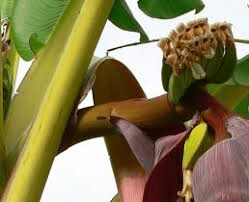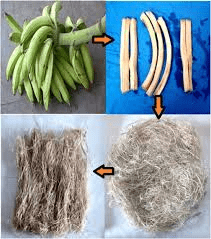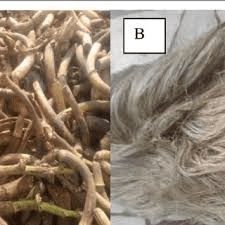The banana peduncle, also known as the banana stem or banana stalk, is the robust structure that connects the cluster of bananas to the main plant. It plays a crucial role in the development and support of the banana fruit and serves various purposes beyond its agricultural significance.
Structurally, the banana peduncle is a thick, fibrous stalk that emerges from the end of the pseudostem, where the banana cluster is attached. It is composed of vascular tissue that facilitates the transport of water, nutrients, and hormones between the plant and the developing fruit. The peduncle is typically green when young and gradually turns brown as the bananas ripen.
In agriculture, the management of the banana peduncle is essential for optimizing fruit production and quality. Farmers monitor the growth and development of the peduncle to ensure proper nutrient uptake and support for the banana cluster. The peduncle also plays a role in determining the timing of harvest, as its color and firmness can indicate the ripeness of the bananas.
Beyond its agricultural role, the banana peduncle has culinary and medicinal uses. In some cultures, particularly in South Asia, the inner core of the peduncle is harvested and used as a vegetable. Known as “banana stem” or “banana pith,” it is valued for its crisp texture and mild flavor. The peduncle is often sliced and cooked in soups, stews, curries, and stir-fries, contributing a unique taste and nutritional benefits to dishes.
Nutritionally, the banana peduncle is low in calories and rich in dietary fiber, vitamins (such as vitamin C and vitamin B6), and minerals (including potassium, calcium, and magnesium). Its high fiber content aids in digestion, promotes gut health, and helps regulate blood sugar levels. The peduncle is also known for its diuretic properties, making it beneficial for detoxification and kidney health.
Medicinally, the banana peduncle has been used in traditional remedies for various health conditions. It is believed to have anti-inflammatory properties, which can help reduce swelling and relieve pain. The peduncle is also used to treat urinary tract infections and promote urinary health due to its diuretic effects. Additionally, it is used in herbal preparations to support liver function and detoxification processes.
Culturally, the banana peduncle holds significance in culinary traditions and cultural practices in tropical regions. Its use as a vegetable and medicinal herb reflects the cultural diversity and culinary creativity of communities where bananas are cultivated. The peduncle is also used in traditional rituals and ceremonies, symbolizing fertility, prosperity, and auspicious beginnings.
Environmentally, the utilization of banana peduncle in culinary and medicinal practices supports sustainable agriculture by minimizing waste and maximizing the use of all parts of the banana plant. This holistic approach helps conserve natural resources and reduce environmental impact, promoting ecological stewardship and resilience in agricultural systems.
The banana peduncle is a versatile and valuable component of the banana plant, with agricultural, culinary, medicinal, cultural, and environmental significance. Its nutritional benefits, culinary versatility, and cultural symbolism highlight its importance in tropical and subtropical societies. As a sustainable resource, the banana peduncle exemplifies the integration of natural resources into diverse human practices, promoting health, cultural heritage, and environmental sustainability.
The Economic Importance and Uses of Banana Peduncle

1. Culinary Uses: Banana peduncle, also known as banana stem or stalk, is used as a vegetable in various cuisines. It is cooked in dishes such as salads, curries, and soups.
2. Nutritional Value: Banana peduncle is rich in fiber, vitamins (especially vitamin B6 and C), minerals (such as potassium and calcium), and antioxidants. It provides a nutritious addition to diets.
3. Traditional Medicine: In traditional medicine practices, banana peduncle is used to treat ailments such as kidney stones, urinary tract infections, and digestive issues.
4. Edible Stalk: The inner core of the banana peduncle is edible and used in culinary preparations. It is peeled, sliced, and cooked to make dishes like stir-fries and stews.
5. Animal Feed: Banana peduncle can be used as fodder for livestock, providing them with essential nutrients.
6. Fiber Production: The fibers from banana peduncle are used in the production of textiles and handicrafts. The process involves extracting, drying, and weaving the fibers.
7. Biofuel Production: Banana peduncle can be processed into biofuels such as ethanol through fermentation or biogas through anaerobic digestion, providing renewable energy sources.
8. Composting: Banana peduncle is excellent for composting, enriching soil with organic nutrients as it decomposes.
9. Natural Dye: Extracts from banana peduncle are used to produce natural dyes for textiles and other materials. This involves boiling the peduncle and extracting the dye.
10. Biodegradable Materials: Fibrous materials from banana peduncle can be processed into biodegradable packaging materials, reducing environmental impact.
11. Herbal Teas: Infusions made from banana peduncle are consumed as herbal teas, believed to have health benefits such as detoxification and digestion aid.
12. Soil Enrichment: Decomposed banana peduncle is used as organic fertilizer, improving soil fertility and structure.
13. Water Purification: The fibers from banana peduncle can be used in water purification systems to filter impurities.
14. Culinary Extracts: Extracts from banana peduncle are used in culinary applications for flavoring and nutritional enhancement.
15. Art and Crafts: Parts of banana peduncle are used in art and crafts for their unique texture and appearance. This involves drying and preserving the peduncle.
16. Beekeeping: The nectar from banana peduncle flowers attracts bees, supporting beekeeping and pollination activities.
17. Sustainable Agriculture: The cultivation and use of banana peduncle promote sustainable agricultural practices due to its multiple uses and low environmental impact.
Read Also: Long Haired Cat Breeds Description and Complete Care Guide
The Products and By-products That Can Be Derived From Banana Peduncle

1. Culinary Dishes: Banana peduncle is used in a variety of culinary dishes such as salads, curries, and soups. The process involves cleaning, peeling, and slicing the peduncle.
2. Nutritional Supplements: Extracts from banana peduncle are used in nutritional supplements due to their high nutrient content. The process includes drying and powdering the peduncle.
3. Traditional Medicine: Banana peduncle is used in traditional medicine for kidney stones, urinary tract infections, and digestive issues. The process involves preparing infusions or extracts.
4. Animal Feed: Chopped banana peduncle is used as feed for livestock, providing essential nutrients. The process includes harvesting and processing the peduncle.
5. Fiber Production: Fibers from banana peduncle are used in textile production and handicrafts. The process involves extracting, drying, and weaving the fibers.
6. Biofuel Production: Banana peduncle can be processed into biofuels such as ethanol through fermentation or biogas through anaerobic digestion. This provides renewable energy sources.
7. Composting: Banana peduncle is beneficial for composting, providing organic material that breaks down into nutrient-rich compost. This involves chopping and mixing the peduncle with other organic waste.
8. Natural Dye: Extracts from banana peduncle are used to produce natural dyes for textiles. The process includes boiling the peduncle and extracting the dye.
9. Biodegradable Materials: Fibrous materials from banana peduncle can be processed into biodegradable packaging materials. This involves pulping and molding the fibers.
10. Herbal Teas: Infusions made from banana peduncle are consumed as herbal teas, believed to have health benefits such as detoxification and digestion aid. The process involves drying and brewing the peduncle.
11. Soil Enrichment: Decomposed banana peduncle is used as organic fertilizer, improving soil fertility and structure. This involves composting the peduncle and applying it to crops.
12. Water Purification: The fibers from banana peduncle can be used in water purification systems to filter impurities. This involves processing the fibers and using them in filtration systems.
13. Culinary Extracts: Extracts from banana peduncle are used in culinary applications for flavoring and nutritional enhancement. This involves extracting and purifying the compounds.
14. Art and Crafts: Parts of banana peduncle are used in art and crafts for their unique texture and appearance. This involves drying, preserving, and shaping the peduncle for various artistic purposes.
15. Beekeeping: The nectar from banana peduncle flowers attracts bees, supporting beekeeping and pollination activities. This involves cultivating banana plants and harvesting the peduncle for its nectar.
Read Also: Complete List of Different Types of Cat Breeds
Frequently Asked Questions (FAQ’s) About Banana Peduncle

1. What are banana peduncle used for?
Banana peduncle is used for culinary dishes, nutritional supplements, traditional medicine, animal feed, fiber production, biofuel production, composting, natural dye, biodegradable materials, herbal teas, soil enrichment, water purification, culinary extracts, art and crafts, beekeeping, and sustainable agriculture.
2. How do you prepare banana peduncle for cooking?
To prepare banana peduncle for cooking, remove the tough outer layers, slice the inner core, and cook it in dishes like curries, stir-fries, or soups.
3. Are banana peduncle edible?
Yes, banana peduncle is edible and used in various culinary dishes, especially in Asian cuisines.
4. What are the health benefits of banana peduncle?
Banana peduncle is rich in fiber, vitamins, minerals, and antioxidants. It is used to treat kidney stones, urinary tract infections, digestive issues, and is beneficial for overall health.
5. Can banana peduncle be used in natural dye production?
Yes, extracts from banana peduncle are used to produce natural dyes for textiles. The process involves boiling the peduncle and extracting the dye.
6. How are banana peduncle used in composting?
Banana peduncle is beneficial for composting, providing organic material that breaks down into nutrient-rich compost. This involves chopping the peduncle and mixing it with other organic waste.
7. What are biodegradable materials made from banana peduncle used for?
Fibrous materials from banana peduncle are processed into biodegradable packaging materials, reducing environmental impact. They are used as an eco-friendly alternative to plastics.
8. Can banana peduncle be used in herbal teas?
Yes, infusions made from banana peduncle are consumed as herbal teas, believed to aid in detoxification and digestion.
Read Also: Design criteria for comminutor and Grinder

